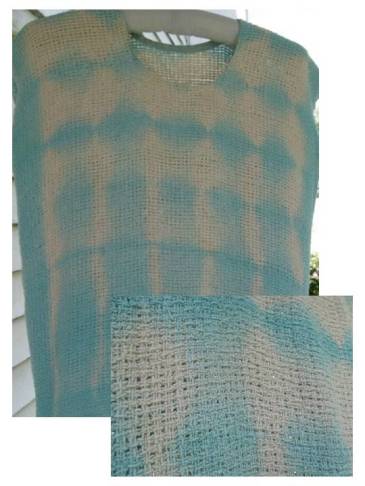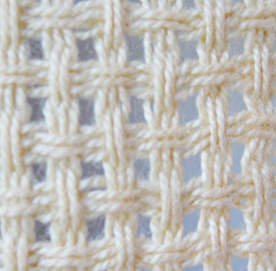I first learned to weave true leno in the late 70’s using a pick-up stick on my rigid heddle loom and later on experimented on my floor loom with bead leno, doup leno, as well as mock leno.
Having said that, I decided to backtrack and do some research to learn more about leno. I found many articles in different weaving magazines as well as various descriptions in several weaving books. My notes from Desiree Koslin’s ‘Weave Construction & Analysis’ class from the 80’s has the clearest distinction between true and mock leno: “Mock leno weaves are those weaves which create open or lace-like effects without using leno twisting of warp ends.”
I also bought Irene Emery’s book, The Primary Structures of Fabrics (considered a classic reference book on terminology and structures of fabrics). There’s a fascinating chapter (pp. 180-192) on leno/gauze with historical and etymological explanations as well as detailed descriptions of the various types. Mock leno/imitation gauze is also explained on pp. 124-127.
Below are images of leno weavings I’ve done in the 80’s with additional information about each one.
True Leno:
There are two types of true leno: 1) weaver-controlled leno – the warp ends are twisted with the fingers and a pick-up stick or sword is used to help in making the twist stay in place and 2) loom-controlled leno – this includes bead and doup leno where a device is added to the loom that eliminates the tedious task of picking up the warp ends and twising them with the fingers.
I used a pick-up stick to weave the leno in the Purple Top. The warp ends are rayon and cotton yarns sett at 8 epi and the weft is a thicker cotton yarn. I drew the illustration to show a simple leno twist of 2 warps ends (1 end twisted once with 1 end). The detailed image of the Purple Top shows a twist of 2 warp ends (1 end twisted twice with 1 end) as well as a twist of 4 warp ends (2 ends twisted once with 2 ends). The pick-up stick is turned on its side so that a shed is created, the weft is passed through, the pick-up stick is removed and, in this case, plain weave is resumed.
If you’re interested to learn more about true leno, there are several great articles that include pick-up, bead and doup leno, all in one issue of Weaver’s magazine (#15, 4th Quarter 1991). Also, there’s a wonderful article on doup leno on Weavezine from November 30, 2008, by Irma Spaargaren, “Give it a Twist: Doup Leno.” If you want something really challenging, there’s a book by Ulla Nass, Harness Lace, that she published in 1977. There is also a post by John Marshall on Japanese leno, karamiori, that is fascinating and beautiful.
Mock Leno:
I wove the Noil Silk Top using single/medium weight noil silk sett at 10 epi. I wove a lot of yardage and made different things from it, and this particular piece was tie-dyed using fiber reactive dyes. There was considerable shrinkage after the finishing process and the open, lacy effect shows really well, it’s incredibly light and I still wear it sometimes so many years later. I got this commonly used weaving draft for mock leno from the time I freelanced as a sample weaver for textile companies. In some of the weaving articles I read, other open weaves such as Bronson lace are mentioned along with mock leno and also discussed in Emery’s book.
Here’s a 4 shaft version of mock leno woven as Huck lace:
I’m not sure if this may be called mock leno:
But I’m including this Linen Top under mock leno because the fabric is open or lace-like and fits the definition of mock leno I mentioned at the beginning. It also fits Emery’s definition because she says that mock leno is an “effect of openworks” and “not a specific structure.” I used 10/2 linen sett at 12 epi and space-dyed the linen using fiber reactive dyes in several color batches before making the warp. This Linen Top is one of my favorites.








